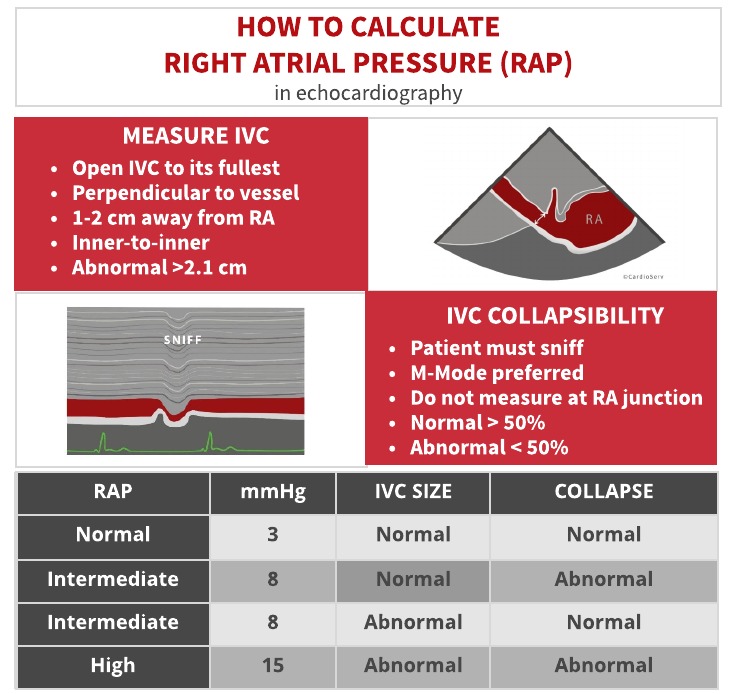After our last post on ‘how to estimate the right atrial pressure’, we received questions from our readers. What do we do if we cannot assess the IVC? What if the patient is on a vent? This week we will answer those questions.

Review prior article for information on:
- Why estimate Right Atrial Pressure (RAP)?
- What does the IVC have to do with the RAP?
- What is the collapsibility Index?
HOW TO ESTIMATE RIGHT ATRIAL PRESSURE (RAP)

As noted in the above table, the two components required to estimated RAP with echocardiography include assessing both the size and collapsibility of the IVC. Once you have established if these values are normal or abnormal, you can accurately calculate the estimated RAP.
IVC Tips:
- Be sure to fully elongate the IVC for both size and collapsibility assessment
- Yes..you need to have the patient sniff! This inspiratory maneuver causes a brief and sudden emptying of blood from the IVC to the RA causing the IVC collapse
- No sniff = insufficient collapse of IVC
QUESTIONS FROM OUR READERS
As with all of our material, we reference the American Society of Echocardiography Guidelines. (2015 Quantification Guideline Paper)
What do we do if we cannot assess the IVC size?
- Use an intermediate value of 8 mmHg
- Integrate other findings that may justify normal or abnormal RAP
- Dilated right atrium
- Interatrial septum that bulges into the left atrium throughout the cardiac cycle
- NOTE: “These additional findings are qualitative and comparative, and do not allow the interpreter to assign an RA pressure but if present, these other findings should prompt a more complete evaluation of RA pressure as well as a search for possible etiologies (ASE 2015).”
What are some reasons that cause a dilated IVC?
- Healthy young athletes may have dilated IVCs in the presence of normal pressures
- The IVC is commonly dilated and may not collapse in patients on ventilators
- In these cases, the IVC size should not be used to estimate RA pressure
What if the patient is on a ventilator?
- As mentioned, the IVC is commonly dilated and may not collapse in patients on ventilators
- The IVC diameter, measured on TEE at the RA junction, has been successfully used to derive a central venous pressure in anesthetized mechanically ventilated patients
- You can estimate the pulmonary artery pressure (PAP) on the basis of the tricuspid regurgitant jet velocity, rather than assuming a constant RA pressure for all patients
Can we use the central venous pressure for ventilated patients, irrespective of IVC size?
Yes, if the patient has a central venous line, the right atrial pressure (RAP) is the central venous pressure (CVP).
Additional articles that may be helpful:
All this information comes directly from the ASE Chamber Quantification Guidelines Paper. We always recommend that our readers review these standards
- 2 Ways to Properly Assess TR Jets for Accurate RVSP Calculations
- What the Heck is the Cut-off Value for RVSP?!
- 6 Tips for Calculating RVSP
- TAPSE and RVSP – Prognostic Value When Viewed as an Index
SUMMARY
This week, we reviewed the collapsibility index and answered readers’ questions regarding assessing the RAP in the absence of accurate IVC assessment.
We love to hear from our readers so, keep the questions coming! Next week we will review the less common method of evaluation the RAP using tissue Doppler (TDI).
Judith Buckland, MBA, RDCS, FASE
 Find Category 1, AMA CMEs related to the echo assessment of the right heart
Find Category 1, AMA CMEs related to the echo assessment of the right heart
References:
Lang, R. et al. (2015). Recommendations for Cardiac Chamber Quantification by Echocardiography in Adults: An Update for the American Society of Echocardiography and the European Association of Cardiovascular Imaging. Journal of American Society of Echocardiography, 28(1). Retrieved from https://www.asecho.org/wp-content/uploads/2016/02/2015_ChamberQuantificationREV.pdf






